When you wonder just how far technology has come, take a look at these 10 major technology innovation comparisons.
1. Electric burglar alarm

The first electric burglar-alarm was patented by Reverend Russell Pope in 1853, but in 1857 Edwin Holmes acquired the patent rights for $1,500 and began production. The alarm reacted to the closing of an electric circuit so doors and windows were connected as independent units by a parallel circuit. If the door or window was opened and the electric circuit was closed, the sudden flow of current would cause one of the attached magnets to vibrate. The vibrations were then transmitted to a hammer which then struck a brass bell. The bell could not be turned off by simply closing the window either. Instead, a switch spring was mounted into the wall to keep the current interrupted so that that the bell could keep ringing.
2. Electric-powered dental drill

In 1875, George F. Green of Kalamazoo, MI invented an electric-powered device to drill teeth. The device included an electromagnetic motor and was designed to prevent tooth decay by filing and polishing teeth. Today’s drills use compressed air from an air turbine engine which allows for high rotational speeds from 200,000 rpm to 800,000 rpm. In the future, dentists would like to eliminate the drill altogether. Currently, there is research being done to see if teeth could naturally repair themselves using minerals and a small electric current.
3. Telephone

Alexander Graham Bell patented the telephone in 1876. Since then, we’ve come all the way to phones that act more like computers.
4. Incandescent light bulb

The first incandescent light bulb was created by Thomas Edison in 1879. Edison had received $30,000 in research funds provided by inventors like J.P Morgan and the Vanderbilts in order to create the bulb. Today, the incandescent light bulb is actually being phased out in favor of more energy-efficient lighting alternatives. Alternatives include LEDs and compact fluorescent lamps (CFLs).
5. Engine-powered vacuum cleaner
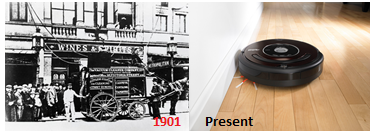
In 1901, engineer H. Cecil Booth patented a vacuum cleaner that was powered by an engine and mounted upon a horse-drawn cart. Vacuuming would require a team of operators to reel the horses into buildings to be cleaned. Not only are modern-day vacuums smaller and practical, but some like the iRobot Roomba, featured in the image above, even vacuum your home for you.
6. Video games
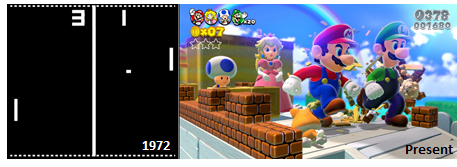
In 1972, Noland Bushnell created Pong (featured on left above), one of the first mass-produced video games. Bushnell eventually went on to found Atari. Today there are more video games than we can count and the graphics are slightly better than they were 40 years ago.
7. Polaroid camera

In 1947 Dr. Edwin Land invented the Polaroid camera which could produce a developed photo in just 60 seconds. In the 1960s a color model came out and a few hundred additional patents were born after.
8. Cylinder printing press
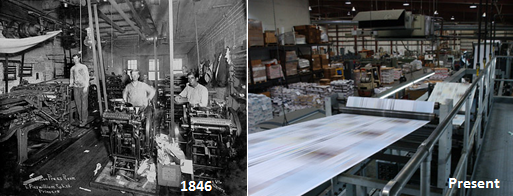
The cylinder printing press was created in 1846 by Richard M. Hoe. The press worked by rolling a cylinder over plates of inked type which resulted in an impression on the paper. This eliminated the task of printing impressions directly from the individual type plates which were heavy and difficult to maneuver. Today, web offset printing is ideal for newspapers, magazines, catalogs and small paperback books. The rolls of paper used in today’s web offset printing can weigh over 2,000 lbs. and can be several miles long. The paper runs through the press at a rate of anywhere between five and 50 feet-per-second. This has become one of the most cost effective ways to print large quantities.
9. Rockets
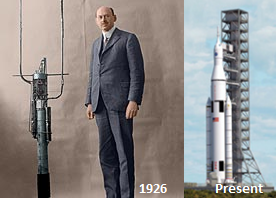
In 1926, Robert Goddard successfully launched the first liquid-fueled rocket in Massachusetts. The first-of-its-kind rocket reached an altitude of 41 ft., lasted 2 seconds and averaged about 60 mph. He is pictured above with his rocket. It looks a little different than today’s version. Right next to Goddard you can see the Space Launch System used for Earth orbital flights and long-range missions to asteroids, Mars, and other moons.
10. Human-powered flight
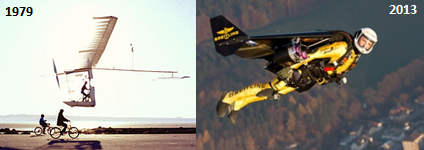
In 1979, cyclist Byron Allen crossed the English Channel in a pedal-powered aircraft. The flight took 2 hours and 49 minutes. The craft was constructed of Mylar, polystyrene, and carbon-fiber rods and possessed a wingspan of almost 94 ft. Fast forward to 2013 where a Swiss inventor (nicknamed “Jetman”) created a suit that enables him to fly up to 12,000-ft high.
Advertisement
Learn more about Electronic Products Magazine





